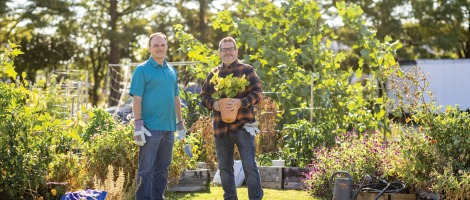Tending to your church’s garden: A guide to revitalization and replanting
by Bonnie Shaw on October 26, 2021 in Church Health & Growth

Sometimes, when a garden is overgrown but still producing fruit, some hard work is all it takes to get the garden back on track. But sometimes, when a garden is so full of brambles that things can no longer grow there, the garden needs to be replanted to see fruit there once again.
Whether a church is a little overgrown or covered in brambles, Texas Baptists has ministries ready to help. Read below as Jonathan Smith, director of Church Health Strategy, and Tom Howe, associate director of the Center for Missional Engagement, talk through the differences between church revitalization and church replanting and how both can enable churches to fulfill God’s purpose for them.
Revitalizing a fruit-bearing church
When people hear that a church is being “revitalized,” the first reaction can often be to assume that the church is in decline. Jonathan Smith, director of Church Health Strategy, says that’s not always the case. In fact, he believes that revitalization can be for churches of all sizes and seasons of life.
“In revitalization, you get the chance to see the problems and the possibilities. You need to look around and see your community and see all the people that could be saved,” Smith said. “You have to look at the problems and face them, but you also have to dream about the possibilities to go forward.”
In his role, Smith comes alongside churches to evaluate their strengths and weaknesses and to help churches make a plan to strengthen one or more areas. Recently, he helped a small church in Temple that was already growing under new leadership improve their guest retention rate by helping church leadership map out the guest experience from the parking lot all the way to membership classes. The plan will make it easier for the church to invest in and disciple people who are new to the church or new to faith.
Digging up and replanting
Replanting is for churches with so many brambles and problems that it is no longer bearing meaningful fruit. This process is much harder than revitalization and comes with sacrifices as a church is reborn.
“There are moments of nostalgia, reflection and closure. But then there’s a new birth and new work, and there’s excitement and optimism for what God is going to do,” Tom Howe, associate director of the Center for Missional Engagement, explained. “I remind people that this church was built by people who were hopeful about what God was going to do in this community in this church. We have the opportunity to do that again. We can celebrate what’s been done in the past, and we can prepare ourselves for what God will do in the future.”
Howe walks churches through the replanting process, helping them make the necessary changes to be successful. He explained that one of the most critical things church replants do is look at their changing communities and identify a new plan to reach the people around them more effectively. For example, if a church primarily offers ministries for married couples, but their surrounding neighborhood has changed to be mostly young singles, the church will need to create new ministries and opportunities to better serve those in their area.
“There’s a growing, changing community around the church, and they need to adjust to meet that,” Howe said. “There are things we’re not going to ever change, like our theological principles or anything like that. But there also needs to be a surrender in order for change and growth.”
Howe shared the story of one church in Fort Worth whose doors were about to close in 2019. They had less than 12 members, and the facilities had fallen into disrepair as they could no longer afford the upkeep. Howe was able to connect the church with some grants to repair the building, and the church changed its name and made changes to better engage with the young community around them. Now, in 2021, that church is thriving, with about 130 people attending on an average Sunday.
Both revitalizing and replanting a church are hard work. Smith and Howe hope that by helping churches along in the process, they can help them remain focused on the most important mission of all: sharing Christ with the world.
For more information on church revitalization, contact Jonathan Smith at Jonathan.Smith[at]txb.org. For more information on church replanting, contact Tom Howe at Tom.Howe[at]txb.org.
Texas Baptists is a movement of God’s people to share Christ and show love by strengthening churches and ministers, engaging culture and connecting the nations to Jesus.
The ministry of the convention is made possible by giving through the Texas Baptists Cooperative Program, Mary Hill Davis Offering® for Texas Missions, Texas Baptists Worldwide and Texas Baptist Missions Foundation. Thank you for your faithful and generous support.
Subscribe to receive stories like this one directly to your inbox.
We are more together.
Read more articles in: Church Health & Growth, Church Health, Missional Engagement
More from Bonnie Shaw
- 2022 Annual Meeting celebrates unwavering commitment to sharing Christ and showing love
- 2022 Missions Banquet looks towards sharing the gospel with ‘every nation, tribe and language’
- Texas Baptists messengers elect new officers, raise budget for second consecutive year
- Pastor’s Common Rally provides space for collaboration, fellowship for young ministry leaders
- Equipping believers to defend their faith in the Philippines and in Texas